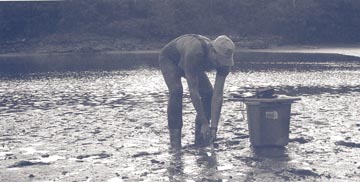
|
Digging
for Answers in Lobster Pounds Telltale markers of the lobster industry are endemic along much of the Maine coast: multicolored buoys peppering the ocean surface, muscular lobster boats steaming out to haul in traps, the bright crustaceans clambering over each other in bubbling tanks at fish markets and seaside restaurants. But there's one critical step in the process of bringing lobsters to market of which most consumers are unaware, and that's the lobster pound. These pounds are holding areas in which lobstermen keep their catch to avoid glutting the market with lobsters ó and driving down the price per pound. In New England, most lobsters are harvested in the autumn, when the animals' shells are hard, and the weather has not yet turned too harsh for fishing. Lobstermen generally begin filling the pounds in October and have emptied them by April. The pounds themselves are dammed-off inshore areas, often up to two acres large and a few feet deep. Aerators are used to ensure good water quality, and ingoing and outgoing tides assure nearly complete water exchanges. The lobsters are fed a feed similar to the bait used to catch them.
However, little is known about the ecological effects of placing perhaps thousands of lobsters in an area that might naturally contain a dozen crustaceans. So Michael Tlusty, a research scientist with the New England Aquarium, has been studying the sediments in lobster pounds. The research is funded by MIT Sea Grant. "I'm very interested in seeing how aggregating animals in certain areas impact the environment," says Tlusty. Having conducted such research with salmon in Newfoundland, Tlusty was aware that no similar studies had been conducted with lobsters. And while his salmon study was a $4 million project with a full ecosystem analysis of how aquaculture interacts with the environment, for the pound study, he opted for the far less expensive approach of examining sediments. Tlusty's colleagues in the project are Diane Cowan, senior scientist with the Lobster Conservancy in Maine, and Jean Finney-Crawley, a researcher in the Department of Biology at Memorial University of Newfoundland. Basically, Tlusty is looking at the feed being put into the pound, how much the lobsters are taking up, how much they are excreting, and how much is being deposited on the bottom. His work includes taking sediment cores three times a year from each of 10 locations in Maine, each of which has six to eight collection sites. These include pounds currently in use and those no longer active, in order to make comparisons between active and inactive pounds. (Tlusty notes that coastal waters in Massachusetts are too crowded for pounds.) "At each site we take cores of the sediment to see how much organic matter has accumulated in the layers. We also dig down 10 cm over a .25-square-meter area and look at all the large organisms that we can find," says Tlusty. "Finally, we skim the top 2 cm and look at the nematode [a type of worm] abundance." Finney-Crawley is the nematode expert and her effort, says Tlusty, will add an important additional layer to the study. Back at the lab, Tlusty burns the core samples at 500 degrees C to determine the amount of organic matter present. The feed provided to lobsters in pounds is typically 80-90 percent organic matter. Tlusty has found that adult lobsters excrete roughly 40 percent of that organic matter, and about 5 percent shows up in the sediments. "It's easy to account for the loss from the feed to what comes out of the lobster," he says. "But what is happening to that other 35 percent? Some of it is washed out. Some is getting eaten by anthropods or bacterial degradation. We are looking at this loss. If the lobsters are really putting out 40 percent, why aren't we seeing higher levels in the sediment?" The answer, says Tlusty, may be that the organic compounds are being flushed out of the pounds with outgoing tides. This would also explain why the researchers have not found a significant difference in the level of organic compounds in active and inactive pounds. In looking at the presence of larger animals, Tlusty has found many fewer mussels inside pounds than outside of themónot a surprise given that they are a lobster's natural food. What was a surprise, says Tlusty, were some findings from lab experiments conducted to learn about how lobsters process food. "People have suggested that food can get through a lobster's digestive track in 18 hours," says Tlusty. However, when the researcher starved the lobsters, then fed them 3 percent of their body weight, he found that the animals were still processing the same meal for 20 days. Do lobster pounds impact the environment? "Yes, just by the sake of damming the area you are affecting it," says Tlusty. "Even if you don't put a lobster in it, you are impacting the system." But, he also adds that he and his colleagues have tried to identify inshore areas that look like they could be used as pounds, and so far, these pristine areas have all had higher levels of organic matter than the pounds. "When you are dealing with the coast, you're dealing with these naturally mucky areas," he says. Tlusty is now anxiously awaiting the nematode findings, which will present another way to index how the ecosystem responds to any change in function. "The abundance and diversity of nematodes gives you an idea of how much a location is being disturbed," explains Tlusty. "Highly disturbed or high energy places have nematodes that are 'colonizers,' while calm and undisturbed sites have 'persisting' nematodes." Overall, he says, he had expected the impact of pounds to be much greater. But he's quick to add: "Anytime you look at nature you're going to get surprised by something. I'm always surprised by doing this work at how resilient ecological systems are."
|
